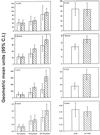Antibodies to variant antigens on the surfaces of infected erythrocytes are associated with protection from malaria in Ghanaian children
- PMID: 11349035
- PMCID: PMC98376
- DOI: 10.1128/IAI.69.6.3713-3718.2001
Antibodies to variant antigens on the surfaces of infected erythrocytes are associated with protection from malaria in Ghanaian children
Abstract
Plasmodium falciparum erythrocyte membrane protein 1 (PfEMP1) is a variant antigen expressed on the surface of infected erythrocytes. Each parasite genome contains about 40 PfEMP1 genes, but only 1 PfEMP1 gene is expressed at a given time. PfEMP1 serves as a parasite-sequestering ligand to endothelial cells and enables the parasites to avoid splenic passage. PfEMP1 antibodies may protect from disease by inhibiting sequestration, thus facilitating the destruction of infected erythrocytes in the spleen. In this study, we have measured antibodies in Ghanaian children to a conserved region of PfEMP1 by enzyme-linked immunosorbent assay and antibodies to variant molecules on erythrocytes infected with field isolates of P. falciparum by flow cytometry. Based on close clinical monitoring, the children were grouped into those who did (susceptible) and those who did not (protected) have malaria during the season. The prevalences of antibodies to both the conserved PfEMP1 peptide and the variant epitopes were greater than 50%, and the levels of immunoglobulin G (IgG) correlated with age. The levels of antibodies to both the conserved peptide and the variant epitopes were higher in protected than in susceptible children. After correcting for the effect of age, the levels of IgG to variant antigens on a Sudanese and a Ghanaian parasite isolate remained significantly higher in protected than in susceptible children. Thus, the levels of IgG to variant antigens expressed on the surface of infected erythrocytes correlated with protection from clinical malaria. In contrast, the levels of IgG to a peptide derived from a conserved part of PfEMP1 did not correlate with protection from malaria.
Figures



References
-
- Afari E A, Appawu M, Dunyo S, Baffoe-Wilmot A, Nkrumah F K. Malaria infection, morbidity and transmission in two ecological zones in southern Ghana. Afr J Health Sci. 1995;2:312–316. - PubMed
-
- Baruch D I, Pasloske B L, Singh H B, Bi X, Ma X C, Feldman M, Taraschi T F, Howard R J. Cloning the P. falciparum gene encoding PfEMP1, a malarial variant antigen and adherence receptor on the surface of parasitized human erythrocytes. Cell. 1995;82:77–87. - PubMed
-
- Berendt A R, Turner G D H, Newbold C I. Cerebral malaria: the sequestration hypothesis. Parasitol Today. 1994;10:412–414. - PubMed
-
- Bruce-Chwatt L J. A longitudinal survey of natural malaria infection in a group of West African adults. W Afr Med J. 1963;12:141–173. - PubMed
Publication types
MeSH terms
Substances
LinkOut - more resources
Full Text Sources
Research Materials

